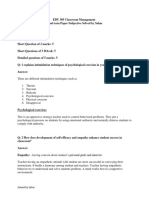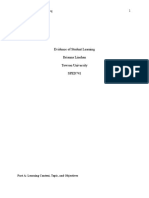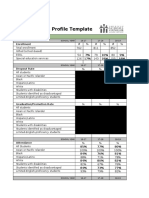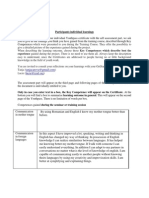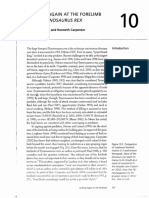0 ratings0% found this document useful (0 votes)
45 viewsSecondary Lesson Plan: TH TH
Secondary Lesson Plan: TH TH
Uploaded by
api-456796301This secondary lesson plan aims to help 7th and 8th grade students understand their own learning styles. The counselor will have students take a learning style quiz and discuss how identifying their style can help them in school. Students will then get into groups to discuss what to do if a lesson does not match their style, and the strengths and weaknesses of each style. The counselor will evaluate the lesson by tracking student participation, measuring understanding of learning styles, and determining whether students can apply the information by identifying their own style and incorporating it into study habits.
Copyright:
© All Rights Reserved
Available Formats
Download as DOC, PDF, TXT or read online from Scribd
Secondary Lesson Plan: TH TH
Secondary Lesson Plan: TH TH
Uploaded by
api-4567963010 ratings0% found this document useful (0 votes)
45 views2 pagesThis secondary lesson plan aims to help 7th and 8th grade students understand their own learning styles. The counselor will have students take a learning style quiz and discuss how identifying their style can help them in school. Students will then get into groups to discuss what to do if a lesson does not match their style, and the strengths and weaknesses of each style. The counselor will evaluate the lesson by tracking student participation, measuring understanding of learning styles, and determining whether students can apply the information by identifying their own style and incorporating it into study habits.
Original Title
ascalesson planportfolio
Copyright
© © All Rights Reserved
Available Formats
DOC, PDF, TXT or read online from Scribd
Share this document
Did you find this document useful?
Is this content inappropriate?
This secondary lesson plan aims to help 7th and 8th grade students understand their own learning styles. The counselor will have students take a learning style quiz and discuss how identifying their style can help them in school. Students will then get into groups to discuss what to do if a lesson does not match their style, and the strengths and weaknesses of each style. The counselor will evaluate the lesson by tracking student participation, measuring understanding of learning styles, and determining whether students can apply the information by identifying their own style and incorporating it into study habits.
Copyright:
© All Rights Reserved
Available Formats
Download as DOC, PDF, TXT or read online from Scribd
Download as doc, pdf, or txt
0 ratings0% found this document useful (0 votes)
45 views2 pagesSecondary Lesson Plan: TH TH
Secondary Lesson Plan: TH TH
Uploaded by
api-456796301This secondary lesson plan aims to help 7th and 8th grade students understand their own learning styles. The counselor will have students take a learning style quiz and discuss how identifying their style can help them in school. Students will then get into groups to discuss what to do if a lesson does not match their style, and the strengths and weaknesses of each style. The counselor will evaluate the lesson by tracking student participation, measuring understanding of learning styles, and determining whether students can apply the information by identifying their own style and incorporating it into study habits.
Copyright:
© All Rights Reserved
Available Formats
Download as DOC, PDF, TXT or read online from Scribd
Download as doc, pdf, or txt
You are on page 1of 2
Secondary Lesson Plan
School Counselor: Zuri Cannon
Date: September 25, 2018
Activity Title: Know Thyself
Grade(s): 7th and 8th
ASCA Mindsets & Behaviors:
M2: Self confidence in the ability to succeed
M5: Belief in using abilities to their fullest to achieve high quality results and outcomes
B Learning: Apply self-motivation and self-direction to learning
B Self-Management: Demonstrate the ability to overcome learning barriers
Three Learning Objectives:
1. Students will have a greater understanding about their learning needs
2. Students will understand how to apply their learning style to their academic studies
3. Students will learn ways in which they can seek help or greater understanding
Materials:
Learning Style Quiz
Emoji print outs
Access to SIA – “The Greatest” music video
Detailed Description of Procedures:
Greet the students. Run a quick check-in with three emoji, raise one at a time and ask the students if
they feel like what they think the emoji represents. Summarize the overall feelings of the class.
Overview the activities for the day. Introduce that we will be discussing learning styles. Ask the class
that they know about learning styles. Clarify as needed. Ask them to write down which learning
style they think best fits how they learn. Play Sia’s music video “The Greatest.” Let them know that
the song reminds me so much of them, because of all of their potential. Ask them whether it was
more important for them to watch, listen or move with the music. Ask them to write it down. Have
them take the Learning Style Quiz. Ask them to write down their results and see if they were
consistent. Ask the students how knowing their learning style could help them in school. Facilitate
this conversation so that the students have a good understanding. Ask the students to get into
groups, and discuss what they could do if they felt like their lesson was not conducive to their
learning style. Then ask them to discuss the strengths and weakness of each style. Emphasize that
one is not better than the others, but some are more conducive to the classroom setting. Summarize
and link student responses to normalize and reiterate learnings.
Plan for Evaluation: How will each of the following be collected?
Process Data: The number of children who participate in the lesson about learning styles; facilitated
by a school counselor, supported by homeroom instructors.
Perception Data: Students will have a better understanding of learning styles and how to identify
them. Students will also problem solve when the lessons they receive may not fit their learning style.
Students will gain a deeper understanding of their own personal styles and how to apply this
knowledge into the future.
Outcome Data: 100% of the students will know what their learning styles are. 70% of the students
will be able to apply this information to their study and classroom habits.
Follow Up: Check in with the instructor, report to them the learning styles of their students. Offer
suggestions on how to be inclusive, especially if there is an overwhelming majority of a learning style
present in the classroom. Visit the student periodically, and see how they are functioning in class.
You might also like
- Ppat Task 1 Re-SubmitDocument7 pagesPpat Task 1 Re-Submitapi-21355372967% (3)
- Hacking Questions: 11 Answers That Create a Culture of Inquiry in Your ClassroomFrom EverandHacking Questions: 11 Answers That Create a Culture of Inquiry in Your ClassroomRating: 5 out of 5 stars5/5 (4)
- Small Group CurriculumDocument5 pagesSmall Group Curriculumrichie foremanNo ratings yet
- Task 4 SubmissionDocument11 pagesTask 4 Submissionapi-213553729100% (1)
- Sparing PhilosophyDocument1 pageSparing PhilosophyKevin J. Mills100% (2)
- Classroom Guidance LessonsDocument14 pagesClassroom Guidance Lessonsapi-579811020No ratings yet
- Scool Counseling Lesson PlanDocument6 pagesScool Counseling Lesson Planapi-2856296510% (1)
- Interactive Read Aloud The Bad SeedDocument5 pagesInteractive Read Aloud The Bad Seedapi-438529073No ratings yet
- Grade 9 Lesson PlanDocument3 pagesGrade 9 Lesson Planapi-284117276No ratings yet
- Why Use Cooperative LearningDocument3 pagesWhy Use Cooperative LearningKurniawan IldiNo ratings yet
- Edu305 Final Term PapersDocument16 pagesEdu305 Final Term PapersXahidNo ratings yet
- Common Teacher Interview Questions and Best Answers Enko InterviewDocument8 pagesCommon Teacher Interview Questions and Best Answers Enko InterviewGopolang Muriel MatsilaNo ratings yet
- Lesson PlanDocument4 pagesLesson Planapi-264917596No ratings yet
- Classroom Management: 12 Common Teacher Interview Questions and Best AnswersDocument14 pagesClassroom Management: 12 Common Teacher Interview Questions and Best AnswersOliver RecareNo ratings yet
- Reflective Lesson PlanDocument6 pagesReflective Lesson PlanstraitmiNo ratings yet
- Lesson 4Document7 pagesLesson 4api-316937046No ratings yet
- Research Project ProposalDocument4 pagesResearch Project Proposalapi-268935004No ratings yet
- interview nhuiglyfguytfuytfcutkfDocument8 pagesinterview nhuiglyfguytfuytfcutkfDianne De Gula MorcillaNo ratings yet
- Lesson 4Document4 pagesLesson 4Fahma AbdulleNo ratings yet
- 311 W5 6 3 Formative Assessment Part 2Document20 pages311 W5 6 3 Formative Assessment Part 2Alibai Guiapal SalakobNo ratings yet
- FS1 Chapter 3Document25 pagesFS1 Chapter 3princesslove.taduraNo ratings yet
- Evidence of Student LearningDocument24 pagesEvidence of Student Learningapi-355328122No ratings yet
- Prof Ed 6 - Unit 3Document2 pagesProf Ed 6 - Unit 3Hya Balasabas - DaganganNo ratings yet
- Morena Lemus Self - Reflexion About A Good Teaching PracticeDocument10 pagesMorena Lemus Self - Reflexion About A Good Teaching PracticeMorena LemusNo ratings yet
- Argumentation and Debate LessonDocument6 pagesArgumentation and Debate Lessonapi-283604512No ratings yet
- Sel User GuideDocument33 pagesSel User GuideSanjay Kumar KanaujiaNo ratings yet
- 4 Strategies of AfLDocument13 pages4 Strategies of AfLSadiaNo ratings yet
- Learning Assessment StrategiesDocument26 pagesLearning Assessment StrategiesJeric MaribaoNo ratings yet
- Small Group CurriculumDocument3 pagesSmall Group Curriculumapi-299663993100% (1)
- Using Collaborative Strategic Reading: By: Janette K. Klingner and Sharon Vaughn (1998)Document6 pagesUsing Collaborative Strategic Reading: By: Janette K. Klingner and Sharon Vaughn (1998)Hendra Nazhirul AsrofiNo ratings yet
- JournalDocument7 pagesJournalirwin andriyantoNo ratings yet
- My Final Action PlanDocument22 pagesMy Final Action Planapi-344976308No ratings yet
- SOAR Full PlanDocument16 pagesSOAR Full PlanLaura WittNo ratings yet
- Small Group Response Services: 1st GenerationDocument9 pagesSmall Group Response Services: 1st Generationapi-270423618No ratings yet
- Ela Edtpa LessonDocument5 pagesEla Edtpa Lessonapi-313445058No ratings yet
- Evaluation of In-Class QuestionsDocument5 pagesEvaluation of In-Class QuestionsfeyzanrkvkliNo ratings yet
- Takaki Journey Box Lesson PlanDocument6 pagesTakaki Journey Box Lesson Planapi-267854883No ratings yet
- Educ 304 Field Study Episode 4Document6 pagesEduc 304 Field Study Episode 4bedioirene4No ratings yet
- Inquiry-Based Teaching StrategiesDocument21 pagesInquiry-Based Teaching StrategiesMaria Cristina Importante75% (4)
- Summarizing: in Upper ElementaryDocument30 pagesSummarizing: in Upper Elementaryapi-600626782No ratings yet
- 3 Quarter Final PT - ENGLISH 7 (Written Interview)Document3 pages3 Quarter Final PT - ENGLISH 7 (Written Interview)Cla RisaNo ratings yet
- T1 Instruction - EDUC 330 - Claire Warschauer: Health Class - Cambridge Middle SchoolDocument16 pagesT1 Instruction - EDUC 330 - Claire Warschauer: Health Class - Cambridge Middle Schoolapi-531205732No ratings yet
- Myron Clark Elementary:) State Standards and Student Outcomes-Learning Goals - Standards - OutcomesDocument3 pagesMyron Clark Elementary:) State Standards and Student Outcomes-Learning Goals - Standards - Outcomesapi-360053901No ratings yet
- Lesson 5 Conflict Resolution StrategiesDocument9 pagesLesson 5 Conflict Resolution Strategiesapi-302111878100% (1)
- The Document When It Is Published: Cover Page For SPED 702 Lesson Plan AssignmentDocument4 pagesThe Document When It Is Published: Cover Page For SPED 702 Lesson Plan Assignmentmosneagu.anaNo ratings yet
- Ptse Tws Complete Website VersionDocument15 pagesPtse Tws Complete Website Versionapi-340615475No ratings yet
- Qualitative Interview QuestionsDocument7 pagesQualitative Interview Questionsapi-624575103No ratings yet
- Lesson Plan Format: Describe The Context: (StudentsDocument5 pagesLesson Plan Format: Describe The Context: (Studentsapi-336537681No ratings yet
- Social Studies Simulation Teaching Presentation Lesson PlanDocument6 pagesSocial Studies Simulation Teaching Presentation Lesson Planapi-241322150100% (1)
- Final Soc Sci 411Document5 pagesFinal Soc Sci 411Christian BarrientosNo ratings yet
- Anti-Bias Lesson FinalDocument13 pagesAnti-Bias Lesson Finalapi-242682914No ratings yet
- Reflective Lesson Plan Model - 450 - Revised 20132edu 328 1Document3 pagesReflective Lesson Plan Model - 450 - Revised 20132edu 328 1api-240741796No ratings yet
- Instructor Growth Self-Evaluation Form: Questions For Self-AppraisalDocument5 pagesInstructor Growth Self-Evaluation Form: Questions For Self-AppraisalPetruţa DianaNo ratings yet
- January 11, 2016 4 Grade Stem: Effective Questioning in STEM ProjectsDocument5 pagesJanuary 11, 2016 4 Grade Stem: Effective Questioning in STEM Projectsapi-317739244No ratings yet
- THESISDocument14 pagesTHESISEarl CecilioNo ratings yet
- Drama Unit 1 - Orientation 2Document12 pagesDrama Unit 1 - Orientation 2api-300773127No ratings yet
- PDPDocument7 pagesPDPapi-302003110No ratings yet
- Literature ReviewDocument7 pagesLiterature ReviewArsalan NadeemNo ratings yet
- PPG 215 Meeting Student NeedsDocument24 pagesPPG 215 Meeting Student NeedsmrajisNo ratings yet
- Lesson 1 BullyingDocument8 pagesLesson 1 Bullyingapi-306675138No ratings yet
- Data Report Northside19Document3 pagesData Report Northside19api-456796301No ratings yet
- Goodvibesonlylessonplan1 6Document6 pagesGoodvibesonlylessonplan1 6api-456796301No ratings yet
- WeeklycalendarsampleDocument3 pagesWeeklycalendarsampleapi-456796301No ratings yet
- SccoverletternorfolkDocument1 pageSccoverletternorfolkapi-456796301No ratings yet
- Schooldataprofilensm 19Document6 pagesSchooldataprofilensm 19api-456796301No ratings yet
- Resume 2019 SchoolcounselingportfolioDocument2 pagesResume 2019 Schoolcounselingportfolioapi-456796301No ratings yet
- Vps 700Document2 pagesVps 700زكي النعيميNo ratings yet
- Youthpass CompetencesDocument2 pagesYouthpass CompetencesAlexandra CiorobeaNo ratings yet
- CS1010S Tutorial 6 PDFDocument24 pagesCS1010S Tutorial 6 PDFsimyanzi1010No ratings yet
- ANSYS Mechanical APDL Theory ReferenceDocument950 pagesANSYS Mechanical APDL Theory ReferenceIcaro MoraisNo ratings yet
- Total Quality Management in Organized Retail Shop From Service Providers Point of View PDFDocument17 pagesTotal Quality Management in Organized Retail Shop From Service Providers Point of View PDFHariyono KediriNo ratings yet
- 9100 Correlation MatricesDocument7 pages9100 Correlation Matriceselango22No ratings yet
- Import Substitution ThesisDocument8 pagesImport Substitution Thesissarahturnerdesmoines100% (2)
- Restatement of The ProblemDocument8 pagesRestatement of The Problemmercadosandra804No ratings yet
- 1 Evaluation Examination - GE Board October 2021Document2 pages1 Evaluation Examination - GE Board October 2021ARNOLD MORANNo ratings yet
- Duplomatic ValveDocument4 pagesDuplomatic ValveHBracing1No ratings yet
- Lesson PlanDocument7 pagesLesson PlanWing Jintalan BuenNo ratings yet
- Elective-I (Core) : Micro and Smart GridDocument2 pagesElective-I (Core) : Micro and Smart GridMahesh ShendeNo ratings yet
- Hashmap DataDocument411 pagesHashmap DataPiyush YadavNo ratings yet
- Experiment 2 EST OLIVA PDFDocument13 pagesExperiment 2 EST OLIVA PDFMark joseph BayletNo ratings yet
- Looking Again at The Forelimb of Tyrannosaurus Rex: Christine Lipkin and Kenneth CarpenterDocument25 pagesLooking Again at The Forelimb of Tyrannosaurus Rex: Christine Lipkin and Kenneth CarpenternomadNo ratings yet
- 04 Malhotra04Document22 pages04 Malhotra04Abhishek JainNo ratings yet
- Lecture Reading 4: Design Methods of Reinforced Concrete StructuresDocument5 pagesLecture Reading 4: Design Methods of Reinforced Concrete StructuresKim CalaguiNo ratings yet
- Group 10 Ge 6 ReportDocument41 pagesGroup 10 Ge 6 ReportJonabel G. MontalboNo ratings yet
- MR1 CompressedDocument1 pageMR1 CompressedDarya BozhkoNo ratings yet
- DLP Week 7 Tle 6Document8 pagesDLP Week 7 Tle 6Harbie EcleoNo ratings yet
- IOM-Air CannonDocument16 pagesIOM-Air CannonAliZenatiNo ratings yet
- Actividad Integradora 5 Applying For A Job: Mi Mundo en Otra Lengua Semana 3 Unidad III. Hobbies and AbilitiesDocument4 pagesActividad Integradora 5 Applying For A Job: Mi Mundo en Otra Lengua Semana 3 Unidad III. Hobbies and AbilitiesStefani VelaNo ratings yet
- Igcse Maths Year 11 Revision Topics Dec 2014Document3 pagesIgcse Maths Year 11 Revision Topics Dec 2014api-241068594No ratings yet
- Automated Version 1Document8 pagesAutomated Version 1coronaqcNo ratings yet
- The Gopalganj Central Co-Operativebank LTD - Gopalganj: Numberofatmattachedtothebranch: OneDocument11 pagesThe Gopalganj Central Co-Operativebank LTD - Gopalganj: Numberofatmattachedtothebranch: OneRUPESH KEDIANo ratings yet
- METHOD STATEMENT - Sub-Base and Aggregate Base Course: June 2018Document10 pagesMETHOD STATEMENT - Sub-Base and Aggregate Base Course: June 2018Tajammal ArifeenNo ratings yet
- Lesson 1.4 Domain and Range of Functions PDFDocument36 pagesLesson 1.4 Domain and Range of Functions PDFhi mynameNo ratings yet
- My Calling..Document1 pageMy Calling..Angelica Mae Angelo BernalNo ratings yet
- Semiflexible, Dual Wall, Moisture-Resistant, Heat-Shrinkable TubingDocument2 pagesSemiflexible, Dual Wall, Moisture-Resistant, Heat-Shrinkable TubingdavidNo ratings yet










